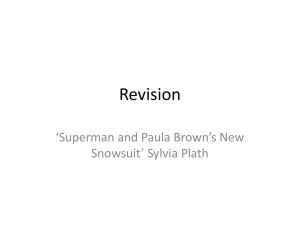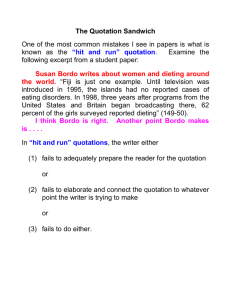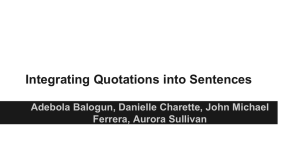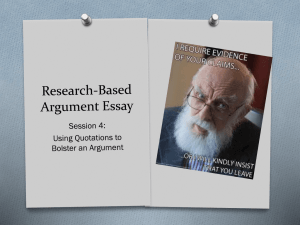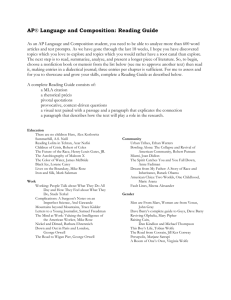Summarizing and Paraphrasing
advertisement
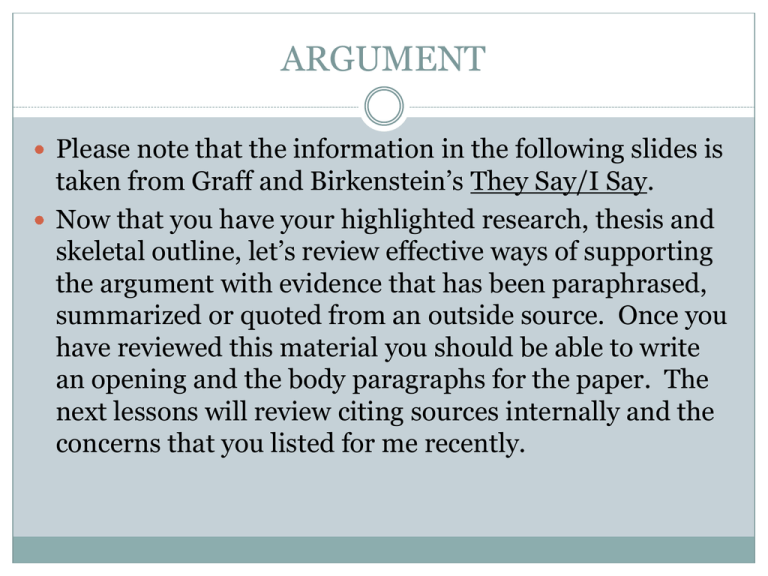
ARGUMENT Please note that the information in the following slides is taken from Graff and Birkenstein’s They Say/I Say. Now that you have your highlighted research, thesis and skeletal outline, let’s review effective ways of supporting the argument with evidence that has been paraphrased, summarized or quoted from an outside source. Once you have reviewed this material you should be able to write an opening and the body paragraphs for the paper. The next lessons will review citing sources internally and the concerns that you listed for me recently. Part 1: Summarizing/ Paraphrasing and Quoting ANY INFORMATION TAKEN FROM A SOURCE MUST BE CITED INTERNALLY AND ON THE WORKS CITED PAGE. Putting Yourself in New Shoes In order to argue persuasively, you need to be in dialogue with others. Summarizing, then, is a central “move” in argument. A good summary must at once be true to what the original author says while also emphasizing those aspects of what the author says that interest you. To write a good summary or paraphrase, you must be able to suspend your own beliefs for a time and put yourself in the shoes of someone else. Writing a good summary means not just representing an author’s view accurately, but doing so in a way that fits your own essay’s larger agenda. Use Signal Verbs Sample templates: She advocates a radical revision of the juvenile justice system. They celebrate the fact that __________. ___________________, he admits. Verbs for Introducing Summaries and Quotations VERBS FOR MAKING CLAIM ARGUE ASSERT BELIEVE CLAIM EMPHASIZE INSIST OBSERVE REMIND US REPORT SUGGEST Verbs for Expressing Agreement ACKNOWLEDGE ADMIRE AGREE ENDORSE EXTOL PRAISE Verbs for Questioning or Disagreeing COMPLAIN COMPLICATE CONTEND CONTRADICT DENY DEPLORE THE TENDENCY TO QUALIFY QUESTION REFUTE REJECT RENOUNCE REPUDIATE Verbs for Making Recommendations ADVOCATE CALL FOR DEMAND ENCOURAGE EXHORT IMPLORE PLEAD RECOMMEND URGE WARN Hang in there. It won’t be long now. . . . . .but don’t forget, first we’ve got finals There were four teenagers who played hooky on the date of the final exam. Upon coming to class in the afternoon, they reported that their lateness was because their car got a flat tire. That’s fine the teacher said, much to the students’ relief. I’ll give you the final now. He then placed each teenager in his own room and gave him the test, which consisted of only one question: “Which tire?” Exercise #1: Summarize or Paraphrase 1. Locate 2 passages from the research articles that you plan to use as evidence in a) the argument and b) the counterargument. These should be passages that you plan to paraphrase or summarize rather than quote. 2. Review the verbs you noted and write a sentence for each paraphrase. 3. Remember to place an internal citation before the conclusion of the sentence. The Art of Quoting The main problem with quoting arises when writers assume that quotations speak for themselves. Because the meaning of a quotation is obvious to them, many writers assume that this meaning will also be obvious to their readers, when often it is not. Remember that quotations are orphans: words that have been taken away from their original contexts and that need to be integrated into their new surroundings. Key Ways to Quote Effectively 1) Choose the quote wisely, with an eye to how well they support a particular part of your text 2) Surround every major quotation with a frame explaining whose words they are, what the quotation means, and how the quotation relates to your own text. Frame Every Quotation Since quotations do not speak for themselves, you need to build a frame around them in which you do that speaking for them. Avoid “hit and run quotations.” Review the passage below: Hit and Run Quotations Susan Bordo writes about women and dieting: “Fiji is just one example. Until television was introduced in 1995, the islands had no reported cases of eating disorders. In 1998, three years after programs from the United States and Britain began broadcasting there, 62 percent of the girls surveyed reported dieting.” I think Bordo is right. Another point Bordo makes is that. . . Make a Quotation Sandwich The statement introducing it is the top slice of bread and the explanation following it serves as the bottom slice. The introductory or lead-in claims should explain who is speaking and set up what the quotations says; the follow-up statements should explain why you consider the quotation to be important and what you take it to say. Templates for Introducing Quotations X states, “not all steroids should be banned from sports.” As the prominent philosopher X puts it, “____.” According to x, “_________.” X himself writes, “_________.” In her book, _____, X maintains that “________.” Writing in the journal Commentary, X complains that ____________.” In X’s view, “_________” X disagrees when he writes, “__________.” X complicates matters further when she writes, “_____.” Templates for Explaining Quotations Basically, X is warning that the proposed solution will only make the problem worse. In other words, X believes ________. In making this comment, X urges us to _____. X is corroborating the age-old adage that _____. X’s point is that _____. The essence of X’s argument is that ______. Revised Hit and Run Remember the accident? Susan Bordo writes about women and dieting: “Fiji is just one example. Until television was introduced in 1995, the islands had no reported cases of eating disorders. In 1998, three years after programs from the United States and Britain began broadcasting there, 62 percent of the girls surveyed reported dieting.” I think Bordo is right. Another point Bordo makes is that. . . CPR on the Hit and Run Sentence The feminist philosopher Susan Bordo deplores Western media’s obsession with female thinness and dieting. Her basic complaint is that increasing numbers of women across the globe are being led to see themselves as fat and in need of a diet. Citing the island of Fiji as a case in point, Bordo notes that “until television was introduced in 1995, the islands had no reported cases of eating disorders. In 1998, three years after programs from the United States and Britain began broadcasting there, 62 percent of the girls surveyed reporting dieting (149-50). Bordo’s point is that the Western cult of dieting is spreading even to remote places across the globe. Ultimately, Bordo complains, the culture of dieting will find everyone, regardless of where he lives. Borado’s observations ring true to me because most women I know, regardless of where they are from, are seriously unhappy with their weight. Overanalyzing a Quotation???? It is better to risk being overly explicit about what you take a quotation to mean than to leave the quotation dangling and your readers in doubt. How NOT to Introduce Quotations You should not introduce quotations by saying something like “Orwell asserts and idea that” or “A quote by Shakespeare says.” Introductory phrases like these are both redundant and misleading. In the first example, you could write either “Orwell asserts that” or “Orwell’s assertion is that,” rather than redundantly combing the two. The second example misleads readers, since it is the writer who is doing the quotation, not Shakespeare. Responding: Disagreeing, with Reasons (For use in your refutation) I think X is mistaken because she overlooks __________. X’s claim that ___________ rests upon the questionable assumption that ___________. I disagree with X’s view that ___________ because, as recent research has shown, ________. X contradicts herself/can’t hae it both ways. On the one hand, she argues _____. On the other hand, she also argues _____. By focusing on _____, X overlooks the deeper problem of _____. Agreeing X is surely right about _____ because, as she may not be aware, recent studies have shown that _____. X’s theory of _____ is extremely useful because it sheds insight on the difficult problem of _____. Those unfamiliar with this school of thought may be interested to know that it basically boils down to _____. I agree that _____, a point that needs emphasizing since so many people believe _____. If group X is right that _____, as I think they are, then we need to reassess the popular assumption that _____. Exercise #2: Quoting Find 2 quotes from your research. Create a frame for each quote that introduces, integrates and then analyzes the material. Just a few more slides, now. . . Part 2: Writing an Opening Provide an attention grabbing device by opening with a startling statistic, interesting anecdote or relevant background information. Supply background information as needed, but do so concisely. Segue into your thesis statement. Sample Opening A striking 80% of Holmdel High School seniors confess to never having read the assigned summer reading book (Simon 45). The assignment, instituted by the Board of Education in 1984, requires students at each grade level to read at least one work of fiction during the summer months (24). . And just for Amanda. . . For Joe, to make up for any drummer slurs. . . And for Lena. . . And just for Jason. . .



